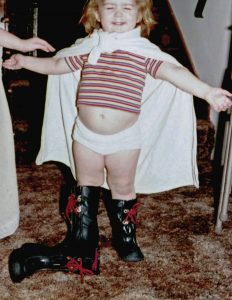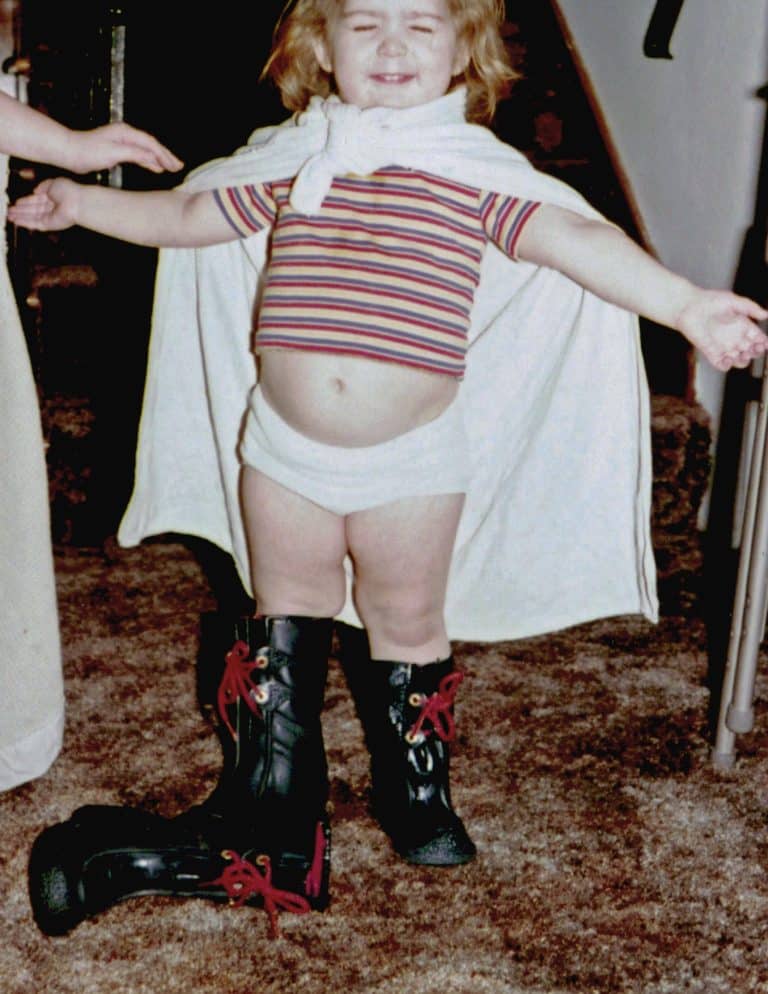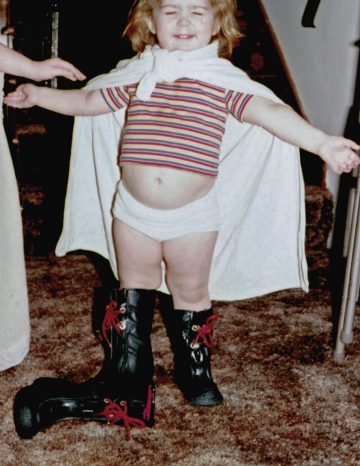This post comes to us from Molly Hadfield, the brilliant illustrator of “Illuminating Ladies: A Coloring Book of Mormon Women.”
When I was quite small, heroines came in red, white and blue, had sweet boots and fantastically amazing hair! They also came in white or brown, but still wore boots and had spectacular hair! I knew Wonder Woman and Princess Leia weren’t real, but I also knew I wanted to be like them. According to legend, I would appear in boots and cape and announce that I was “Chubby Wonder Woman.” (Apparently my body image issues started early). It’s not too hard to believe, seeing as there’s a photograph to accompany the legend. And when Halloween came around each year, there wasn’t much question of what or whom I would be disguised as. If I didn’t have another compelling idea, I went as Leia.

As I grew so did my list of heroines: Anne Shirley, Elizabeth Bennett, Katniss Everdeen. I have always been surrounded by strong, sometimes feisty, women and I knew what to look for. Women who were brave, intelligent, resourceful, and used the appropriate amount of sarcasm at the ideal moment.
As much as I love them, I never really thought to idolize the flesh and blood women around me. Perhaps it was the complex nature of human relations. I also never turned my attentions to the few women I heard about in history or religion classes. Maybe my assumption was that all the REALLY important work had been done by men.
But time and experience can mess with our minds, shift our perspectives, and even smack us upside the head. My human relationships became the catalyst for growth and transformation because I never actively sought to change my perspective. I have several thoughtful and articulate friends and family members who, through conversation and example, compelled me to step outside of my comfort zone in terms of my world-view.
Interestingly, in a time where Joseph Smith is becoming more of a controversial figure, he played a pivotal role in changing my foundational belief of what it means to be a hero. As my loved ones shared with me the unvarnished stories of the beginnings of the Mormon faith, I began to think, “Oh my gosh, that is messed up!” And “Wow, someone who made huge mistakes can also do some incredible things!” I also thought, “Hey, if someone that flawed can make a big difference in this world, then this flawed person can make a difference to!”
I was inspired by reality.
Enter my longtime friend Aimee—a seeker and a doer. She came to me with a project conceived by the Exponent II board to create a coloring book of influential Mormon women. She asked if I wanted to illustrate it. Sold!
She explained that they were compiling a list of women whose stories we would tell and she would get it to me shortly. While I waited, I searched my limited knowledge of Mormon women and thought I would start by illustrating a couple of women I felt had compelling stories—and hopefully they would make the list?!
Martha Hughes Cannon, I thought, was great. I may be biased since she is my great-great-great-aunt by marriage, but she was a doctor, the nation’s first female state senator and beat her husband (my great-great-great-uncle, if you’re keeping track) in the election to gain that position. She was my first illustration.
I thought next of another woman who I knew little about as an individual. I knew though, that Eliza R. Snow had penned words to honor a woman I felt could not be left out of this book—Heavenly Mother. I was fairly giddy with the thought of giving a face to a being I had never seen illustrated before. Though it was one of the first images created for the book, it remains my favorite.
Not long after creating my first two illustrations, I received the list of women whom, for the most part, I had never heard of or knew little about—but I was excited to learn more. See, in spite of never fully identifying as a feminist before, I was fully aware of the dearth of women who were part of the Mormon conversation, and I didn’t feel comfortable with it. I wanted girls to be able to know and see their heritage in a way that I never had.
I decided to illustrate the women for whom there were specific stories that we wanted to portray first, as less research would be required. I enjoyed the process of finding photographs of these women and girls, whenever possible, so that they would be recognizable if people were already familiar with their faces or came upon images of them in the future. There were some for whom I had to imagine what they might look like, use pictures of other family members for reference, or even try to illustrate what they may have looked like at a different age. I tried to familiarize myself with stories and people and locations so I could attempt to capture the scenes in a meaningful and true-to-life manner. I looked for images of period clothing so that they could be dressed in an historically accurate way—I’m sure there are historians out there who can tell me to what extent I failed or succeeded.
As I made my way through the list, I found that much more digging was required for some women. A few of these women’s stories are fairly obscure. I purchased books and watched movies to aid me in my effort to capture the right moment of their lives. In the process, I developed a great respect for people who have gone before to do research to tell the stories of these women and chronicle events in a much more thorough fashion.
Elizabeth Ann Whitney, Lucy Mack Smith, Jane Manning James, and Emmeline Wells—among others—began to populate my mental Mormon history timeline and help me understand ongoing issues and our legacy as Mormon women in a whole new light. Not only that, but I had faces to accompany their stories.
After some time working on the project we determined that we needed to make our cultural representation of women in the book as broad as possible. A web search turned up a blog post from the Juvenile Instructor on a Hawaiian named Hannah Kaaepa. As a young woman she traveled with a delegation of prominent Utah suffragettes to Washington DC to speak to the National Council of Women regarding the plight of the Hawaiian Queen and the efforts of Hawaiian women to gain the vote. Among those she met and addressed were Susan B. Anthony and May Wright Sewell and the deposed Hawaiian Queen herself, Liliuokalani. My family has strong ties to the Hawaiian islands and I found I was particularly drawn to her story. Little is available on Hannah Kaaepa Lowe’s life, but an effort to gather as much information as possible lead me to the Church Family History library and online newspaper archives. I even tracked down a descendant through Ancestry.com. The research lead me to the story of Josepa, Utah, where Hannah lived at the time–a now mostly abandoned town that was created as a colony for LDS members from various Pacific islands to gather.
How did this young lady and her people feel as they left their tropical home to gather with the Saints in the desert? How did it feel when the Islanders were not readily accepted into the pioneer community? How did it feel to be asked to travel across the country to the bustling capitol city and speak before such notable and influential women? How did it feel to experience a great deal of loss and disappointment in her life and still remain determined and faithful? How did all of these women persevere and triumph? I can only imagine, and yet I am inspired.
Carrie Fisher died at the end of this last year. It was for me, the maraschino cherry (not a good thing) on top of the refuse sundae that was 2016. My heroine, or the embodiment of my heroine, had stepped into the eternities. I felt a sense of nostalgia and loss. But I also began to realize that my list of heroines had grown substantially. These heroines came with brown, bare and calloused feet and weathered and work-worn hands. They came covered in bonnet and armed with pen or spade. They came with white hair and bent shoulder. They came in pants and suits and even petticoats, and probably wore some pretty average shoes—but they were REAL—and I am excited to help introduce them to you!
*****
Pre-orders of “Illuminating Ladies: A Coloring Book of Mormon Women” are available now!






3 Responses
I loved reading this. Thank you. And thank you for your care and thought in your beautiful illustrations. I am so eager my children (and myself) to have this.
You can write AND draw?! I am so excited for this. Thank you for your amazing work!
I love these reflections, Molly. Thank you for your amazing work on this project. I can’t even tell you how excited I am about it. I just ordered 15 copies!